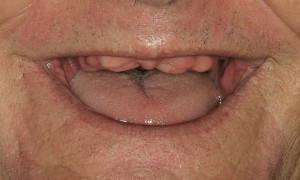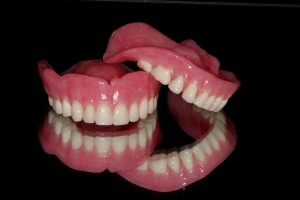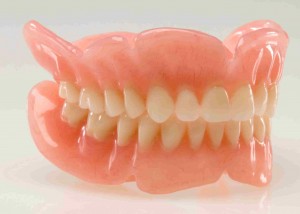If you are missing only a few teeth scattered over either arch (upper or lower teeth), or even if you have a minimum of two teeth on both sides of the arch, then you can most inexpensively replace the missing teeth with a Removable Partial Denture (RPD). There are several types of RPD’s.All of them use standard denture teeth as replacements for the missing natural teeth. The differences between them are the materials that are used to support the denture teeth and retain the RPD in the mouth.
Affectionately known in dentistry as a “flipper”, this is the least expensive of all the removable partial dentures. The pink plastic of the denture base is brittle acrylic, the same material used to make standard full dentures. The largest single advantage to this type of RPD (aside from the cost) is that new teeth and new denture base can easily be added to an existing treatment RPD. These are frequently fabricated even if the remaining teeth have existing decay or periodontal disease and their prognosis is doubtful. If later in the course of treatment some of the existing natural teeth are extracted for any reason, new false teeth can be added quickly to the partial, maintaining the patient’s appearance. In spite of the fact that they are considered a temporary solution, many people keep this type of appliance for many, many years, because as long as they are properly maintained, they look outwardly as good as the more expensive permanent appliances described below.
Flippers do have a number of disadvantages, however.
The acrylic denture base tends to be brittle, and due to their irregular shape, these partials tend to break frequently, especially those made for the lower arch. (Full dentures are more regular in shape and tend to be fairly strong as a result.)
In order to counteract their tendency to break, the acrylic is usually built fairly thick which can take some “getting used to”.
The denture base rests only on the gums, and even though they are much more stable than full dentures, they are much less stable than the more permanent RPD’s which are “tooth born”
As the gums resorb, The false teeth tend to sink below their original level making it necessary to reline them frequently, and sometimes even to reset the teeth which adds to their expense.
Flippers are most frequently retained with wire clasps (shown in image above). These are frequently unsightly due to the limitations that pertain to their placement (they can’t interfere with the way you bite).
Removable Partial Dentures with Cast Metal frameworks are probably one of the oldest forms of dentistry. This type of partial denture offers numerous advantages over the treatment partial described above. A close look at the pictures above will show you that these frameworks are cast to fit the teeth. Since they sit on the teeth, as well as being attached to them, they are extremely stable and retentive. The teeth have been altered slightly beforehand in order that the partial denture can rest upon them without interfering with the way the patient bites the teeth together.
The metal framework does not contact the gums. Thus, as the gums resorb, this type of partial does not sink with them and rarely requires relines. Because the teeth are altered by the dentist beforehand, there are fewer limitations in the placement of clasps, and they are less likely to be seen than the wrought wire clasps of the treatment partial. Modern frameworks are cast from an extremely strong alloy called chrome cobalt which can be cast very thin and are much less likely to break than the all plastic variety. They are also much less noticeable to the tongue.
The most recent advance in dental materials has been the application of nylon-like materials to the fabrication of dental appliances. This material (the most common name brand is ValPlast) generally replaces the metal, and the pink acrylic denture material used to build the framework for standard removable partial dentures. It is nearly unbreakable, is colored pink like the gums, can be built quite thin, and can form not only the denture base, but the clasps as well. Since the clasps are built to curl around the necks of the teeth, they are practically indistinguishable from the gums that normally surround the teeth.
Even though this denture does not rest on the natural teeth like the metal framework variety, the clasps rest on the gums surrounding the natural teeth. This tissue, unlike the gums over extraction sites, is stable and does not tend to change over time which keeps these RPD’s stable and unchanging similar to the cast metal variety.



BPS Dentures made at RAJ LASER DENTAL CARE (Bio-functional Prosthetic System)
What does BPS mean?
Biofunctional:
- The most important demand on your denture is to reproduce the functions of the natural teeth during mastication and speaking to a very high extent.
Prosthetic:
- BPS promotes the fabrication of quality dentures.Only certified dental technicians are authorized to fabricate BPS dentures after thorough analysis of your individual situation.
System:
- BPS dentures are fabricated of especially coordinated materials. The excellent cooperation between the dentist at Trisa Dental Solutions, BPS certified dental technician enables the optimum analysis of your personal data and their use for the fabrication of distinctive BPS dentures.
Advantages of BPS Dentures over Conventional Dentures
- BPS Dentures reproduce the functions of the natural teeth during mastication & Speaking to a very high extent.
- The patient will get a well fitting denture which is stable during functions like chewing, eating, & speaking because the processing of the denture is done by continuous injection moulding technique.
- Even harder foods can be consumed immediately after denture insertion.The usage of high quality teeth sets & the work in the articulator according to the BPS principles makes BPS dentures a masterpiece.
- BPS dentures has high fracture resistant and 25 years clinical approved material.
